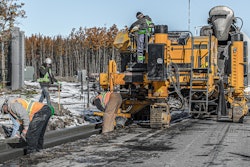
Recent data points to a potential shift in career choices by younger workers. For construction and other skilled-trade organizations, this represents a unique opportunity to attract and retain a generation that can help sustain their talent pipelines for the foreseeable future.
Shift From College Degrees to the Trades
The labor market has undergone changes since 2019, especially regarding career and education choices. More young workers are considering alternatives to traditional four-year degrees.
According to research from the National Student Clearinghouse Research Center, between 2019 and spring 2024, enrollment of bachelor’s degree students fell by 3.6 percent and associate’s degree enrollment fell by 15.9 percent. Vocational enrollment rose by 4.6 percent during the same time period.
Moreover, new labor market data published by ADP Research in Issue 7 of the quarterly Today at Work found the blue-collar share of employment for workers 20 to 24 was 18.6 percent in January 2024, 2.3 percentage points larger than that of the same age group in January 2019 and 2.5 percentage points larger than that of workers 25 to 39.
Why Gen Z Might be Opting for Trades
There are several possible factors contributing to Gen Z's growing interest in blue-collar careers. Blue-collar employers should keep these in mind when recruiting younger workers.
1. Stability and good earning potential: The construction and trade industries often offer stable employment and competitive wages. For many Gen Z workers, avoiding the financial burden of student loans can also be a significant motivator. Trades like carpentry, plumbing and electrical work can offer pathways to well-paying jobs without needing a four-year degree.
2. Hands-on learning and career development: Trades often provide a direct route to career growth through on-the-job training and certifications, which could allow young workers to climb the ranks faster than they might in other sectors. Further, an entry into the blue-collar trades may very lead Gen Z on the path towards entrepreneurship and owning their own business.
3. Technological integration: The modernization of the construction and trade sectors, through innovations like drones, artificial intelligence (AI), 3D printing, and software for the back office could also be a selling point for Gen Z workers who are eager to blend physical work with technology. This tech-forward environment can provide a new appeal to what has traditionally been seen as a hammer-and-nail industry.
How to Retain Gen Z Workers
With the influx of Gen Z workers into blue-collar industries, it is essential for construction and trade companies to also focus on retention strategies. Below are six strategies employers can consider when trying to keep these young workers in the industry:
1. Provide career development opportunities
Employers can offer clear career development roadmaps that help young workers to envision their future in the company. Whether it’s moving from an entry-level position to project management, gaining specialized skills in electrical or plumbing work, or transitioning to environmental and infrastructure projects, the opportunities for growth in construction are diverse.
Employers can also offer talent management tools to help managers track progress and ensure workers receive the training and guidance they need to advance in their careers. By providing a structured plan for growth, companies can demonstrate their commitment to employees’ long-term success.
 The construction and trade industries often offer stable employment and competitive wages.@ivanko80 - adobe.stock.com
The construction and trade industries often offer stable employment and competitive wages.@ivanko80 - adobe.stock.com
2. Offer a path to entrepreneurship
Many Gen Z workers are entrepreneurial by nature, desiring autonomy and the freedom to be their own boss. The trades can offer a clear pathway to entrepreneurship, whether that means starting a large contracting business or specializing in a niche skill set. Employers can embrace this entrepreneurial spirit by providing resources that teach the ins and outs of running a business.
Instead of fearing that workers will leave to start their own ventures, construction companies can use this aspiration as a retention tool. When workers know that staying with their employer might give them the skills and experience needed to eventually run their own business, they may be more inclined to remain in the industry longer.
3. Develop tech-forward jobs and training opportunities
The integration of technology in the trades can be a major selling point for Gen Z workers. As technology continues to revolutionize the industry, younger workers need opportunities to learn new skills related to cutting-edge technologies like AI and drones. Employers who invest in training programs and technologies that teach these skills might have more success in retaining workers by helping them remain relevant in an evolving job market.
A tech-forward job environment also demonstrates that the trades are not static. Instead, these industries are adapting and changing, making them exciting and dynamic places to work.
4. Stay competitive on pay
Competitive pay will always remain a tentpole retention tactic. Companies should keep pace with salary expectations and regularly benchmark their compensation packages against industry, age, and geographical standards. Compensation benchmarking tools can help employers stay on top of market rates, helping ensure they offer attractive wages that keep young workers engaged.
5. Provide a tech-savvy workplace
Gen Z has grown up in a digital-first world. As a result, they likely prefer their work experience, from the hiring process to day-to-day operations, to be tech-enabled and mobile-friendly. Employers can leverage technology platforms that help simplify processes such as work boot reimbursements, scheduling and payroll.
A streamlined, digital-first approach not only can make life easier for employees but also can improve engagement and retention by helping to create a work environment that feels intuitive and responsive.
6. Offer competitive benefits tailored to younger workers
Gen Z has a unique perspective on benefits. While traditional benefits like medical, dental and retirement plans are still important, younger workers also prioritize non-traditional perks such as mental health counseling, days of service, pet insurance and flexible work schedules. According to an ADP Employee Pulse Survey of 3,000 full-time employees, paid family and medical leave, employee training and tuition reimbursement are among the most sought-after benefits for this generation.
By offering a comprehensive benefits package that addresses both traditional needs and new ones aligned with Gen Z values, construction companies could better attract and retain these workers.
As Gen Z moves into the trades at a faster pace than previous generations, construction and other blue-collar organizations have a unique opportunity to build a skilled, tech-savvy and entrepreneurial workforce. To help retain these workers, companies can offer career development opportunities, competitive pay, tech-forward training and benefits that align with Gen Z’s values.
By meeting the needs and expectations of this generation, employers are more likely to secure a stable workforce that can continue to drive innovation and growth in the industry for years to come.



















